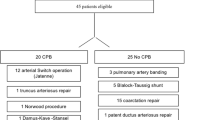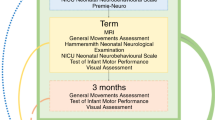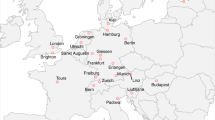Abstract
Background
Children with complex congenital heart disease (CCHD) are at high risk for early neurodevelopmental delays across all domains. Neuromotor delay often emerges first and may impact broader development. Identifying early biomarkers of motor function could capture a critical window for intervention. We assessed the prognostic value of neuron-specific enolase (NSE) and S100B in predicting 4-month motor outcomes in newborns undergoing cardiac surgery with cardiopulmonary bypass (CPB).
Methods
Between December 2021 and October 2024, we conducted a prospective, single-centre study including term neonates with (CCHD) who required cardiac surgery within the first two months of life. NSE and S100B levels were measured at five perioperative time points. Blinded Alberta Infant Motor Scale (AIMS) assessment at four months evaluated motor outcomes.
Results
Of 35 newborns, 27 completed follow-up. Preoperative NSE levels were significantly higher in infants with AIMS scores below the 10th percentile (32.7 vs. 20.9 ng/mL, p = 0.044) and negatively correlated with AIMS percentiles (ρ = –0.617, p = 0.006. There was no significant association between motor outcomes, MRI findings or S100B levels.
Conclusions
Higher preoperative NSE levels predict poor early motor outcomes in CCHD and may be a marker for early risk stratification and intervention.
Impact
-
Neuron-specific enolase (NSE) may serve as an early biomarker of neuromotor development in newborns with complex congenital heart disease (CCHD). Elevated preoperative NSE levels were associated with poorer motor outcomes at four months. NSE may serve as an additional biomarker within a multimodal risk stratification strategy, complementing clinical, imaging, and electrophysiological assessments to refine prognostic evaluation. These findings highlight the prognostic value of perioperative biomarkers for predicting early motor outcomes and support earlier identification of at-risk newborns, enabling targeted neurodevelopmental interventions. This work adds new evidence to limited literature on biological predictors of motor development after neonatal cardiac surgery.
This is a preview of subscription content, access via your institution
Access options
Subscribe to this journal
Receive 14 print issues and online access
$259.00 per year
only $18.50 per issue
Buy this article
- Purchase on SpringerLink
- Instant access to full article PDF
Prices may be subject to local taxes which are calculated during checkout




Similar content being viewed by others
Data availability
the datasets used and analyzed during the current study are available from the corresponding author on reasonable request.
References
Hoffman, J. I. E. & Kaplan, S. The incidence of congenital heart disease. J. Am. Coll. Cardiol. 39, 1890–1900 (2002).
Limperopoulos, C. et al. Brain volume and metabolism in fetuses with congenital heart disease: evaluation with quantitative magnetic resonance imaging and spectroscopy. Circulation 121, 26 (2010).
Rollins, C. K. et al. Regional brain growth trajectories in fetuses with congenital heart disease. Ann. Neurol. 89, 143–157 (2021).
Miller, S. P. et al. Preoperative brain injury in newborns with transposition of the great arteries. Ann. Thorac. Surg. 77, 1698–1706 (2004).
Miller, S. P. et al. Abnormal brain development in newborns with congenital heart disease. N. Engl. J. Med. 357, 1928–1938 (2007).
Ehrler, M. et al. White matter microstructure and executive functions in congenital heart disease from childhood to adulthood: a pooled case-control study. Child. Neuropsychol. J. Norm. Abnorm. Dev. Child. Adolesc. 29, 1064–1087 (2023).
Long, S. H., Harris, S. R., Eldridge, B. J. & Galea, M. P. Gross motor development is delayed following early cardiac surgery. Cardiol. Young-. 22, 574–582 (2012).
Turner, T. et al. Language abilities in preschool children with critical CHD: a systematic review. Cardiol. Young 1–11 https://doi.org/10.1017/S1047951122001330 (2022).
Bolduc, M.-E. et al. Motor impairment in children with congenital heart defects: a systematic review. Pediatrics 146, e20200083 (2020).
Verrall, C. E. et al. Cognitive functioning and psychosocial outcomes in adults with complex congenital heart disease: a cross-sectional pilot study. Pediatr. Cardiol. 45, 529–543 (2024).
Panigrahy, A. et al. Relationship of white matter network topology and cognitive outcome in adolescents with d-transposition of the great arteries. NeuroImage Clin. 7, 438–448 (2015).
Westhoff-Bleck, M. et al. Mental disorders in adults with congenital heart disease: Unmet needs and impact on quality of life. J. Affect. Disord. 204, 180–186 (2016).
Kovacs, A. H. et al. Depression and anxiety in adult congenital heart disease: predictors and prevalence. Int. J. Cardiol. 137, 158–164 (2009).
Birca, A. et al. Interplay of brain structure and function in neonatal congenital heart disease. Ann. Clin. Transl. Neurol. 3, 708–722 (2016).
Latal, B. et al. Postoperative amplitude-integrated electroencephalography predicts four-year neurodevelopmental outcome in children with complex congenital heart disease. J. Pediatr. 178, 55–60.e1 (2016).
Gunn, J. K. et al. Amplitude-integrated electroencephalography and brain injury in infants undergoing Norwood-type operations. Ann. Thorac. Surg. 93, 170–176 (2012).
Sprong, M. C. A. et al. Early determinants of adverse motor outcomes in preschool children with a critical congenital heart defect. J. Clin. Med. 11, 5464 (2022).
Gessler, P., Schmitt, B., Prètre, R. & Latal, B. Inflammatory response and neurodevelopmental outcome after open-heart surgery in children. Pediatr. Cardiol. 30, 301–305 (2009).
International Cardiac Collaborative on Neurodevelopment (ICCON) Investigators Impact of operative and postoperative factors on neurodevelopmental outcomes after cardiac operations. Ann. Thorac. Surg. 102, 843–849 (2016).
Hövels-Gürich, H. H. Factors influencing neurodevelopment after cardiac surgery during infancy. Front. Pediatr. 4, 137 (2016).
Verfaillie, C. J. & Delanghe, J. R. Hemolysis correction factor in the measurement of serum neuron-specific enolase. Clin. Chem. Lab. Med. 48, 891–892 (2010).
Gayger-Dias, V. et al. How S100B crosses brain barriers and why it is considered a peripheral marker of brain injury. Exp. Biol. Med. Maywood NJ 248, 2109–2119 (2023).
Fink, E. L. et al. Serum biomarkers of brain injury to classify outcome after pediatric cardiac arrest*. Crit. Care Med. 42, 664 (2014).
Hu, J. et al. NSE and S100β as serum alarmins in predicting neurological outcomes after cardiac arrest. Sci. Rep. 14, 25539 (2024).
Jalali, R. et al. Predicting short- and long-term functional outcomes based on serum s100b protein levels in patients with ischemic stroke. J. Pers. Med. 14, 80 (2024).
Qu, Y. et al. The association between serum S100β levels and prognosis in acute stroke patients after intravenous thrombolysis: a multicenter prospective cohort study. BMC Med. 22, 304 (2024).
Zarei, H., Roshdi Dizaji, S., Toloui, A., Yousefifard, M. & Esmaeili, A. Diagnostic and prognostic values of S100B versus neuron specific enolase for traumatic brain injury; a systematic review and meta-analysis. Arch. Acad. Emerg. Med. 12, e29 (2024).
Trnka, S. et al. S100B protein as a biomarker and predictor in traumatic brain injury. Biomed. Pap. Med. Fac. Univ. Palacky. Olomouc Czechoslov. 168, 288–294 (2024).
Bersani, I. et al. Early predictors of abnormal MRI patterns in asphyxiated infants: S100B protein urine levels. Clin. Chem. Lab. Med. 60, 1745–1752 (2022).
Huang, H.-Z., Hu, X.-F., Wen, X.-H. & Yang, L.-Q. Serum neuron-specific enolase, magnetic resonance imaging, and electrophysiology for predicting neurodevelopmental outcomes of neonates with hypoxic-ischemic encephalopathy: a prospective study. BMC Pediatr. 22, 290 (2022).
Marino, B. S. et al. Neurodevelopmental outcomes in children with congenital heart disease: evaluation and management: a scientific statement from the American Heart Association. Circulation 126, 1143–1172 (2012).
Lenoir, M. et al. Impact of cardiac surgical timing on the neurodevelopmental outcomes of newborns with Complex congenital heart disease (CHD). Front. Pediatr. 11, 1003585 (2023).
Clancy, R. R. et al. Preoperative risk-of-death prediction model in heart surgery with deep hypothermic circulatory arrest in the neonate. J. Thorac. Cardiovasc. Surg. 119, 347–357 (2000).
Jenkins, K. J. et al. Consensus-based method for risk adjustment for surgery for congenital heart disease. J. Thorac. Cardiovasc. Surg. 123, 110–118 (2002).
Schlapbach, L. J. et al. International consensus criteria for pediatric sepsis and septic shock. JAMA 331, 665–674 (2024).
Centers for Disease Control and Prevention. Pneumonia (Ventilator-Associated [VAP] and Non-Ventilator-Associated Pneumonia [PNEU]) Event. https://www.cdc.gov/nhsn/pdfs/pscmanual/6pscvapcurrent.pdf (2025).
Centers for Disease Control and Prevention. Urinary Tract Infection (Catheter-Associated [CAUTI] and Non-Catheter-Associated [UTI]) Events. https://www.cdc.gov/nhsn/pdfs/pscmanual/7psccauticurrent.pdf (2025).
Centers for Disease Control and Prevention. CDC/NHSN Surveillance Definitions for Specific Types of Infections. https://www.cdc.gov/nhsn/pdfs/pscmanual/17pscnosinfdef_current.pdf (2025).
Smit, L. H. M., Korse, C. M. & Bonfrer, J. M. G. Comparison of four different assays for determination of serum S-100B. Int. J. Biol. Markers 20, 34–42 (2005).
Stern, P. et al. Performance characteristics of seven neuron-specific enolase assays. Tumour Biol. J. Int. Soc. Oncodev. Biol. Med. 28, 84–92 (2007).
McCarthy, A. L. et al. Scoring system for periventricular leukomalacia in infants with congenital heart disease. Pediatr. Res. 78, 304–309 (2015).
Dimitropoulos, A. et al. Brain injury and development in newborns with critical congenital heart disease. Neurology 81, 241–248 (2013).
Papile, L. A., Burstein, J., Burstein, R. & Koffler, H. Incidence and evolution of subependymal and intraventricular hemorrhage: a study of infants with birth weights less than 1,500 gm. J. Pediatr. 92, 529–534 (1978).
Greenberg, S. M. et al. Cerebral microbleeds: a guide to detection and interpretation. Lancet Neurol. 8, 165–174 (2009).
Barkovich, A. J. et al. MR imaging, MR spectroscopy, and diffusion tensor imaging of sequential studies in neonates with encephalopathy. AJNR Am. J. Neuroradiol. 27, 533–547 (2006).
Rutherford, M. A. et al. Abnormal magnetic resonance signal in the internal capsule predicts poor neurodevelopmental outcome in infants with hypoxic-ischemic encephalopathy. Pediatrics 102, 323–328 (1998).
Piper, M. C., Pinnell, L. E., Darrah, J., Maguire, T. & Byrne, P. J. Construction and validation of the Alberta Infant Motor Scale (AIMS). Can. J. Public Health Rev. Can. Sante Publique 83(Suppl 2), S46–50 (1992).
Fourdain, S. et al. Gross motor development of children with congenital heart disease receiving early systematic surveillance and individualized intervention: brief report. Dev. Neurorehabilitation 24, 56–62 (2021).
Bouvier, D. et al. Reference ranges for serum S100B protein during the first three years of life. Clin. Biochem. 44, 927–929 (2011).
Abbasoglu, A. et al. Serum neuron-specific enolase levels in preterm and term newborns and in infants 1–3 months of age. Pediatr. Neonatol. 56, 114–119 (2015).
Mazarico, E. et al. Neural injury markers in intrauterine growth restriction and their relation to perinatal outcomes. Pediatr. Res. 82, 452–457 (2017).
Vaughan, T. et al. Can perioperative electroencephalogram and adverse hemodynamic events predict neurodevelopmental outcomes in infants with congenital heart disease?. J. Thorac. Cardiovasc. Surg. 168, 342–352.e7 (2024).
Licht, D. J. et al. Brain maturation is delayed in infants with complex congenital heart defects. J. Thorac. Cardiovasc. Surg. 137, 529–536 (2009).
Hottinger, S. J. et al. Postoperative improvement of brain maturation in infants with congenital heart disease. Semin. Thorac. Cardiovasc. Surg. 34, 251–259 (2022).
Liu, Y., Xu, Y., Li, D., Shi, Y. & Ye, M. Comparison of S100B and NSE between cardiac surgery and interventional therapy for children. Pediatr. Cardiol. 30, 893–897 (2009).
Gunn, J. K. et al. Perioperative risk factors for impaired neurodevelopment after cardiac surgery in early infancy. Arch. Dis. Child. 101, 1010–1016 (2016).
Peyvandi, S. et al. Declining incidence of postoperative neonatal brain injury in congenital heart disease. J. Am. Coll. Cardiol. 81, 253–266 (2023).
Peyvandi, S. & Rollins, C. Fetal brain development in congenital heart disease. Can. J. Cardiol. 39, 115–122 (2023).
Sadhwani, A. et al. Fetal brain volume predicts neurodevelopment in congenital heart disease. Circulation 145, 1108–1119 (2022).
Xu, Z. et al. Association between cerebral microbleeds and neurological outcomes in patients who underwent extracorporeal membrane oxygenation. J. Am. Heart Assoc. 13, e037029 (2024).
Andersen, K. N. et al. Cerebral microhemorrhages in children with congenital heart disease: prevalence, risk factors, and association with neurodevelopmental outcomes. J. Am. Heart Assoc. 14, e035359 (2025).
Win, K. N., Wang, S. & Undar, A. Microemboli generation, detection and characterization during CPB procedures in neonates, infants, and small children. ASAIO J. Am. Soc. Artif. Intern. Organs 1992 54, 486–490 (2008).
Dubois, M., Scott, D. F. & Savege, T. M. Assessment of recovery from short anaesthesia using the cerebral function monitor. Br. J. Anaesth. 50, 825–832 (1978).
Ortinau, C. M. et al. Early-emerging sulcal patterns are atypical in fetuses with congenital heart disease. Cereb. Cortex N. Y. NY 29, 3605–3616 (2019).
Cromb, D. et al. Individualized cortical gyrification in neonates with congenital heart disease. Brain Commun. 6, fcae356 (2024).
von Rhein, M. et al. Severe congenital heart defects are associated with global reduction of neonatal brain volumes. J. Pediatr. 167, 1259–1263.e1 (2015).
Limperopoulos, C. et al. Neurodevelopmental status of newborns and infants with congenital heart defects before and after open heart surgery. J. Pediatr. 137, 638–645 (2000).
Cossart, R. & Garel, S. Step by step: cells with multiple functions in cortical circuit assembly. Nat. Rev. Neurosci. 23, 395–410 (2022).
Dagenais, L. et al. Superior performance in prone in infants with congenital heart disease predicts an earlier onset of walking. J. Child Neurol. 33, 894–900 (2018).
Acknowledgements
We are grateful to all patients and their families who participated in this study. Disclosure of conflict of interest: None of the authors has any conflict of interest to disclose.
Funding
This study was supported by a Young Investigator Grant (AORC Jeune Chercheur) awarded by the GIRCI Méditerranée.
Author information
Authors and Affiliations
Contributions
B.D. conceived the study. TB, WR, LD, NB, and S.D collected and curated the data. NB and SD performed the statistical analyses. NB, SD and BD interpreted the results. B.D., ML, NB, SD drafted the manuscript with input from all authors. All authors critically revised the manuscript and approved the final version.
Corresponding author
Ethics declarations
Competing interests
The authors declare no competing interests.
Consent to participate
Written informed consent was obtained from the parents or legal guardians of all participants prior to inclusion in the study.
Ethical approval
We confirm that we have read the Journal’s position on issues involved in ethical publication and affirm that this report is consistent with those guidelines
Additional information
Publisher’s note Springer Nature remains neutral with regard to jurisdictional claims in published maps and institutional affiliations.
Rights and permissions
Springer Nature or its licensor (e.g. a society or other partner) holds exclusive rights to this article under a publishing agreement with the author(s) or other rightsholder(s); author self-archiving of the accepted manuscript version of this article is solely governed by the terms of such publishing agreement and applicable law.
About this article
Cite this article
Boutalbi, N., Dahan, S., Rozalen, W. et al. Early motor outcomes in infants with complex congenital heart disease: the predictive role of NSE and S100B. Pediatr Res (2025). https://doi.org/10.1038/s41390-025-04437-8
Received:
Revised:
Accepted:
Published:
DOI: https://doi.org/10.1038/s41390-025-04437-8



